The members
of the radar station were formed into relay teams to pull the radar
screen as
they walked on the walkway about the screen to create a rotating beam
because
the gearing mechanism that drove the screen froze in the sub
zero-weather.
The early
part of 1950 brought new personnel to the unit as well as to the base
support
functions. New Amn arriving at various times included Amn: Aldrich,
Castimore,
Cormier, Duhm, Emerson, Kitts, Fish, Nuckols, and Woods. As spring came
upon the
area, the job of gathering-up the fuel drums required a complete survey
of
every usable container to determine its value to be used as a "safe"
container and returned to the barge that came in from our supply base,
Kodiak
NAB. Spring weather also brought with it the opportunity to go fishing
around
the area. King Salmon creek was an ideal location and every one tried
out this
favorite Alaskan sport of fishing for salmon/trout/herring/cod/crab.
Visiting
inspectors and survey groups appeared from Headquarters and began to
access
locations for relocation of the unit. An Officer Enslin was assigned to
replace
Officer Morris which took place in June 1950.
BROOKS Air Force Base, San
Antonio, Texas 1950:
In July
1950 upon Officers' Morris return to Texas the temperature change was
difficult
to adjust to. A Major Carl J. Krula was the Commander and Captain
Thomas G.
Hayes was the Operations Officer. Expansion was the activity for the
136th Rad
Com Scty Sqdrn. Officers Paxton, Njust, Rickert, Ridler and others were
being
trained and assigned units for deployment.
WHAT
WAS IT LIKE? WHAT HAPPENED?
A deeper look into personnel
willing to recall the diversity created in manning a Radio security
function in
the Air force as it got its commitment orders to go into it and devise
a system
that could insure the security of our own radio waves as utilized and
to then
under a separate system devise a group of unites associated with
knowing what
else was going in the world of electronics associated with units of
other
countries.
In a rapid review Officer
Morris returned to the Headquarters 136th Rad Sec Sqdrn in July 1950 and acclimatized for a
period. The next development in Headquarters was the expansion of
Detachments
into functioning units and getting equipments allocated and prepared
for
shipment; coupled with the training of operators to carry out the radio
monitoring mission to which the units may be assigned upon deployment.
Initially, the units were set-up on "rattle-snake hill" which is the
space that once housed the Aerospace Medical Forces Headquarters prior
to its
becoming Brooks-City Base. A great part of the area is now a very
lovely golf
course. Changes were rather rapid and Officer Morris was sent to take
charge of
the Det "J", McClellan AFB, Sacramento, California, in the early fall
of 1950.
A summary of items
associated with the 136th Radio Security Detachment "J" located at
McClellan Air Force Base, California 1950 to 51 and with units of other
countries.
136th RSS –
Det.
“J”., McClellan AFB, California
Arriving in California was
indeed a pleasure and a privilege. However, numerous problems with the
detachment location and discipline was presented and had to be dealt
with. A
great number of airmen returning from Alaska were being reassigned to
Det. J,
the unit reflected sort of a family reunion and things began settle
down. The
relocation of the unit away from an entry-way to the Base for
semi-trailer
trucks was not a good radio reception area. Numerous alternatives were
tested
and to no avail, difficulties with property availability and priorities
associated with the then build-up-for-the-Koreanpolice-action was
difficult
and produced nothing satisfactory for relocation. The Base Commander
was M/Gen
Junius W. Jones, West Point Class of 1913, and as an interest in our
mission
took on the privilege of advising Officer Morris of his
responsibilities and
requirements as an Officer to his unit, himself and the military
community in
general. I was advised of my position and summarily dismissed. OUCH!
C'est la
vie!
An Exercise/Special
Operations took place in the late fall and winter of 1950
at an auxiliary Air Base, Indian Spring, Nevada. Members
of
Det. "J" were dispatched TDY over "Donner-Pass" and with a
stop in Truckee before driving on down thru Nevada to the location.
Unfortunately, snow hit the Pass as the first part of the convoy
arrived and a
rough time was spent as the storm delayed movement and the team enjoyed
the
rest stop in the "Fabled location." The mission was interesting and
the testing at "YUCCA FLATS" gave everyone a serious look at weaponry
being tested for the arsenal. The site location on the AFB was
approximately
25+ miles from ground-zero with a mountain range between the unit and
target;
the shock wave required the Jamesway Hut used as a monitoring station
to be
evacuated due to structural implosion and explosive air currents. The
plywood
antenna mast all did a real Hula-Hula dance and not in synchronization,
all
survived. The Base control tower lost a few obstruction lights and two
of our
Airmen Bob Roehrs and Don Foresman climbed the framework and replace
them,
visitor courtesy.
Airman Don Vandegraft and I
returned with the entire team via the southern route back to McClellan
AFB when
the mission was complete. A Capt Sandstrom came on board and Officer
Morris was
returned to Headquarters Brooks AFB, then recognized as the 136th
Communications Security Squadron. Detachments were still being formed
and
locations were being selected. Back in December 1951 Officer Morris had
been
promoted to Captain and was now the Commander of Detachment 15,
preparing for
deployment. In June 1952 Officer Morris was transferred to the Projects
Branch,
Implementation Div under the DCS/Operations as the OIC.
This concludes the
association of Officer Morris with the functions of the 136th CSS.
Subsequent
assignments were with the DCS/Operations and the development of the
Radio
Squadron Mobile units throughout the world.
To further expand on the
many things happening to units and people a contact with
Officer Njust was made and here is
what he had to say---"
Hello Bob Morris & Dick
Bergman:
Glad to hear from you, Bob.
Dick Bergman was an intercept operator who trained at Brooks at some
point
during the time span in the subject line 1950-52. And Dick, Bob was an
officer
who was the Opns Chief and Commander of the 136th Detachment at Daly
City, Ca.
(just south of San Francisco, Ca., certainly a "hardship tour").
[noted in error should read Det "J", McClellan AFB, Sacramento,
California] He can fill you in on some of the details as yours address
should
print-out on the E-mail. Bob and I were both stationed at Mather AFB
&
Randolph AFB at times in our careers. Bob is also a retired Colonel and
lives
in San Antonio. And Bob, Dick went to and graduated from at least one
University (G.I.Bill)
and became a
Registered Psychologist employed in that Profession until he
"Retired". He lives in Wisconsin. Dick and I finished our USAFSS
assignment at the 136th/36thCSS Detachment in Weisbaden (which was like
Daly
City, only colder and the Natives were mostly not "Gay").
I came to Brooks AFB to the
136th Comm. Scty. Sqdrn. in the middle of the summer 1950. I had
returned ftom
Tokyo, Japan early that year to an assignment as an NCOIC of a Flight
Line
Aircraft Maintenance Shop at Westover AFB, Chicopee Falls, Mass. I had
volunteered to the newly established USAF Security Service and was
(frankly) a
bit dismayed when the Orders came thru four months later! I had been an
E-5
(S/Sgt.) before starting Pilot training in 1943 and had accumulated
another
four years in Grade after (Reenlisting in July) 1946 with no likely
prospects
for advancement in sight (our Wing in Tokyo at Haneda Air Field had
promoted
only one Staff to Tech in the 37 months I was there). I had a "hip
Pocket" Reserve Commission as a 2nd Lt. that I'd obtained when I was
separated from the Army Air Corps in 1945.
Some people in the Pentagon
decided in 1948, in the first of the year that followed the Sept 1947
establishment of the United States Air Force That the USAF would
develop its
own "Army style" Security Service. Some of the cadre of the new Air
Force Command were transferred as volunteers from Ft. George Meade,
Md., the
Hqs. Of the Army Security Agency. USAFSS then had the same manning
tables
(T.O.&E.) as its Army "Parent." There was an identical Army
unit
to the 136th. The USAF was allowed to pick-up some of the Army's
Overseas
Company sized T.O.& E. Organizations and locations (minus the
people). The
136th Detachment at Camp Peri (Freudenburg
Kaseme), Dotzheim, Germany(
on top a ridge above the Rhine River, near Wiesbaden), is a prime
example. It
was Det. 3, of the 136th.
The 136th CSS, at Brooks
Field, was commanded by Major Barnhart. when we arrived on that very
hot day in
early August 1950. He was soon replaced by a more Senior Major; Carl
Krula.
Barnhart became the Squadron Exec. Capt Thomas Hayes was the Operations
Officer
and soon a newly arrived l/Lt. Thomas Townley became the Assistant OIC.
I don't
know for sure, if we had Operation Control of any of the transferable
Army
Security Detachments at that time. In any event, we soon established
our own
Training Detachment "Det 2", and a newly recalled Reserve Officer,
Capt. Pershing was its Commander. His NCOIC was a T/Sgt Virgil Josleyn,
who
was, in turn, ably assisted by T/Sgt. Raymond Little. Other Officers
and NCO's
were detached from the Hdqtrs. of the 136th to Det 2, as they arrived.
We were
receiving Radio Operators and Mechanics from Kessler AFB, too.
I already had a
Cryptographic Clearance(obtained during my Tokyo assignment). For some
reason
never explained, Security Service ran another Clearance investigation
which
kept me unassigned for the first two months at Brooks. I was just one
of
several enlisted man detailed to the Base MARS Station at that time.
Then, one
day I was ordered to report to M/Sgt. Little at Bldg 300. After two
more months
I was recalled to active duty as a 2/Lt. and assigned as the Operations
Officer
of Det 2. I expected to be re-assigned to some other unit because the
NCO's I
worked for were now working for me! But, that did not happen and it
worked out
ok. Bob Fenstermaker, who out-ranked me as a 2/1t. by a few days, and
I, traded
back and forth as the Detachment Commander whenever Bob was away at school. And, a
couple of times newly arrived Captains were sent to the Detachment to gain a little
experience before going abroad to one of the other(newer), Detachments.
Military
life as a tenant Detachment on a 12th Air Force Base (that's right,
USAFSS did
not own the Base) was sometimes difficult for a very junior Commanding
Officer.
We found it necessary to do much of
the
Building maintenance normally done by the Host Command Base Civil
Engineer. Our
people were some of the very best in the Air Force and they did a lot
of work
besides our Mission.
One of our own technical
problems was the High Frequency Antenna "sets" furnished to the
136th"s Detachments. I was a licensed (Class A) Radio Amateur and, it
occurred
to me that what our Detachment needed to monitor the Frequency Spectrum
between
3000 and 20,000 Kilocycles was a single omni-directional antenna to
feed the
20, or so, Radio Receivers we used to listen to the Strategic Air
Command and
other Aircraft on our "training circuits." USAF used compact
"Discone" antennas on top our Air Force aircraft control towers to
talk with airplanes in the VHF spectrum (100 to 156 Mhz) why wouldn't
it work
to up-scale the VHF (l8"high and about 14" in diameter) discone
design to work with a lower cut-off frequency of 3000Khz? I did the
math and
decided to make
use of an abandon light pole
as the center support for an HF discone. We used a flat tinned metal
garbage
can lid screwed-down to the top of the wooden light pole. But first, we
screwed
a dozen, or so, appropriate lengths of discarded aluminum tubing across
the top
of the garbage can lid and soldered concentric circles of #20 copper
"hook-up" wire to convert the assembly electrically, to a disc. Then,
we used the same gauge (still surplus) hook-up wire to simulate a cone
with its
apex bonded with soldered sheet copper located one tenth of a "wave"
below the horizontal disc. The cones numerous wires were spaced
equally, in a
descending circle at a sixty degree-angle to insulators connected to
anchor
pegs in the ground. We connected an RG8-U co-ax feed-line (center
conductor
soldered to the disc, braid soldered to the copper apex of the cone),
ran the
co-ax in to the Electronic Signal Distribution unit, measured the
impedance in
and out of the splitter to the "Radio Receivers" and found a perfect
52 ohms. We turned on the Receivers and found the signal to be 40
decibels
higher than those from the Double-doublet Antenna Farm! We were in
business.
The Headquarters USAFSS
Engineers heard the news about our invention, made some measurements of
performance and went away muttering that it shouldn't work. Twelve
years after,
I happened by a USAFSS Antenna Site at Clark AFB in the Philippines and
there,
in plain sight was "MY" H.
F. Discone, obviously constructed at no small expense by a Commercial
Firm. I
stopped by the organization for an address and later sent them a
picture of our
"first-in-the-Air-Force (1951) antenna”.
Life for our
"troops" was better, financially, in San Antonio than anywhere else
I've been stationed. That is, if you didn't mind sharing your home (on
or off
base) with a remarkable variety of insects! We did mind, so we bought a
brand
new "Spartan Royal Mansion" Trailer Home (33 '9" long). The
Spartan was an all aluminum mobile home and we lived in and enjoyed it
for 10
years (minus a tour in Europe). I'll look for my 201 file and if I find
it,
I'll send more info on the 136th,s early years --- Carroll Njust.
A
note from Fred Wagner:
04/04/06
One
item of interest. Did you know that the Alaskan
Det. had a still setup in their dayroom. I thought it
was for self-use but I learned from a veteran who made
one of the reunions and then passed away that the person
who set up the still was using it as a money-making
enterprise. But his buddies found out where he was
storing the finished product and drank it up so I
don't think he ever made anything from the enterprise.
It is interesting to note that it became so
commonplace that when Gen Lynn visited the Det. no one
thought to take it down. Gen Lynn sniffed the odor
and suggest something to improve the brew but did not
make a big deal about it.
EPILOGUE:
A reunion
in 1998, Reno, Nevada was attended by several of those still with us
and had
also served as members of Detachment" J", McClellan Air Force Base,
Sacramento, California. A second gathering occurred in 1999, St Louis, Missouri. Officer Morris had served
as Commander of
Det. "J" in 1952 prior to Officer Sandstrom, Robert G., assuming
Command.
Pictures are attached showing the area of Detachment “A”,
the
landscape and some of its facilities.
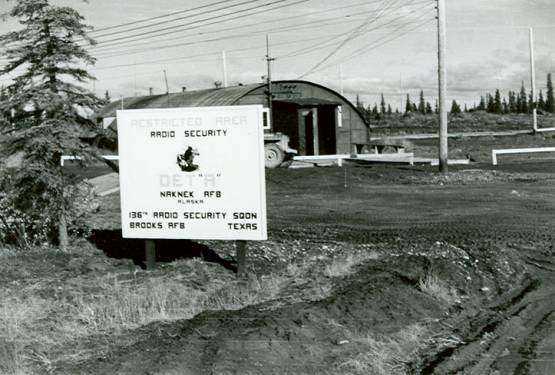
Operations Building and
Headquarters
Det. “A” 136th
Radio Security Squadron
1949
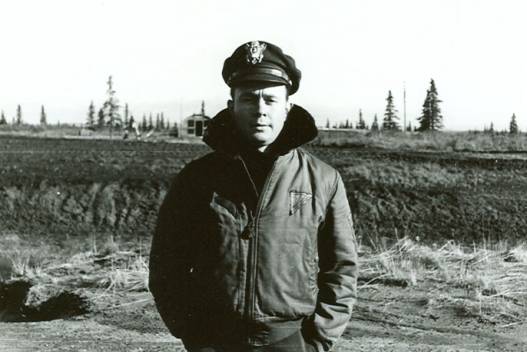
1/Lt Robert E. Morris
August 1949
Naknek Air Base, Alaska
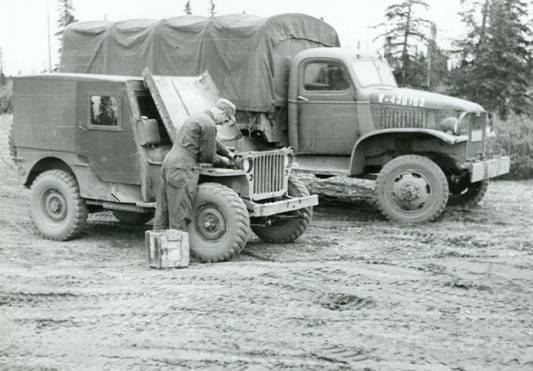
Sgt. Vincent Roduit
performing battery maintainance on jeep
1949
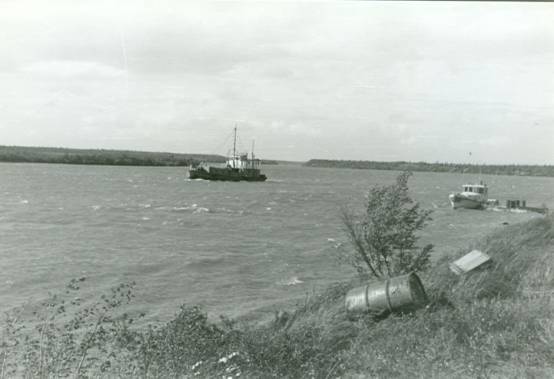
Coastal tugboat on Naknek
river used to bring the fuel barge to
Naknek each spring. 1949
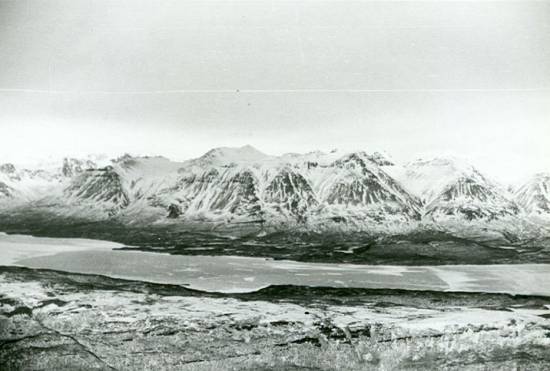
Lake Naknek and the Katmai
National Park and Reserve 1949
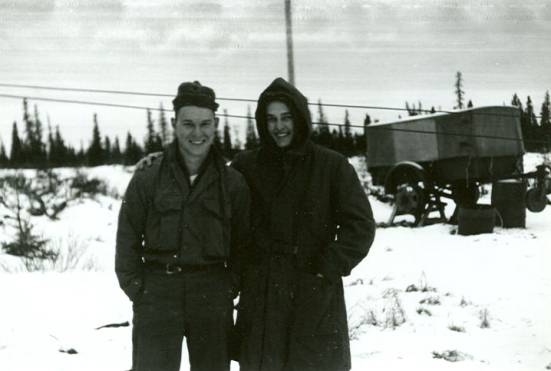
Cottongim and Sabolsky
1949-1950
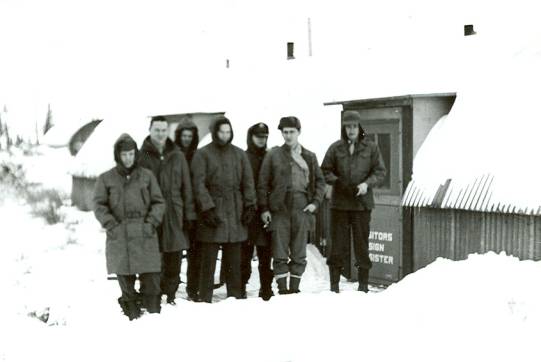
Scheelk, Cottongim,
Tollefson, Fagala, Brown, Roduit and Garland
1949-1950
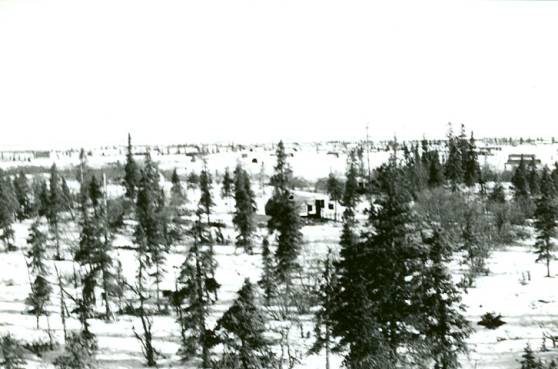
View of the Naknek AB
“Tundra” and abandoned Quonset huts
In it’s area.
1949-1950
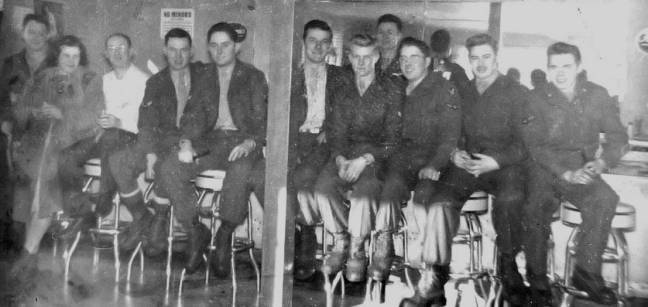
Howdy Bob,
Here
is a photo sent to me by Gene O. Fagala's Mom, she read the history I
gave you
for the USAFSS Web Site and dug out this photo that Gene had taken. The
names
follow: Left to Right --- Proprietress and
Proprietor of the
establishment, Chet Cottingim, Clem Howard(D),
Rob't
Roehrs(D), Glenn Tollefson(D), Morris, Don Scheelk, Baldwin(D), Rob't
Brown.
The
establishment was the one and only Bar available in
the Village of
Naknek and we had a nice lunch and a great visit with every one. Naknek
is the
village location on Bristol Bay about seven(7) miles down
river from the
base over the Tundra.. ... No road. MOE

Donald Scheelk and
wife,Lois. Bob Morris and wife, Barbara.
At the Los Patios
restaurant in San Antonio, Texas.
March, 2005.










